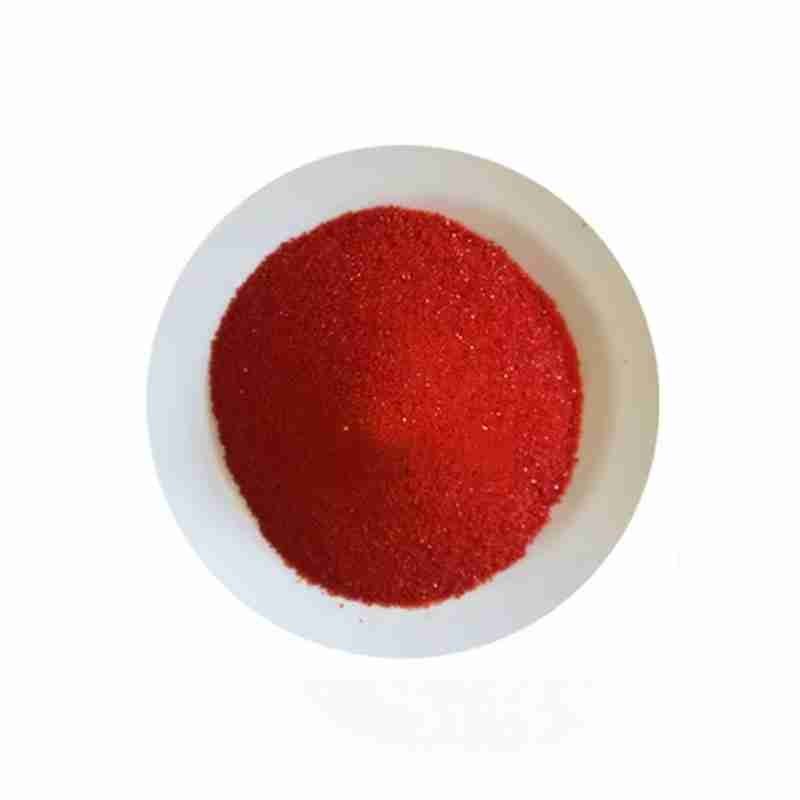Ferric Oxide CAS# 1309-37-1
Ferric oxide exists in nature in the form of hematite. It is the main iron ore for producing metals and their alloys. Moreover, this oxide exists in the mineral limonite 2Fe2O3 ?? 3H2O. One important application of this compound involves the production of red, orange, and yellow pigments. Other applications include coatings for metals, steel, and rubber; In the field of ceramics; And as a catalyst for oxidation reactions.
Ferric oxide is synthesized and mainly composed of anhydrous and/or hydrated iron oxide. The color range includes yellow, red, brown, and black. The main difference between food grade iron oxide and industrial grade iron oxide is that the pollution level of other metals is relatively low. This is achieved by selecting and controlling iron sources and/or the degree of chemical purification during the manufacturing process. Iron oxide has been used for coloring fillings and decorations in candies, pastry products, cheese products, fish sauce, pet food, cosmetics, and pharmaceuticals.
发送询盘
Ferric Oxide CAS# 1309-37-1
| Ferric oxide Basic information |
| Physical Properties?Occurrence and Uses?Preparation?Reactions |
| Product Name: | Ferric oxide |
| Synonyms: | Ferric oxide(II,III), magnetic nanoparticles solution;Ferric(III) oxide;Iron(III) oxide, 99% trace metals basis;Iron(III) oxide, 99.9% trace metals basis;Iron(III) oxide, 98% trace metals basis;Iron(III) oxide, 99.95% trace metals basis;Iron(III) oxide, 99.99% trace metals basis;Iron(lll) oxide |
| CAS: | 1309-37-1 |
| MF: | Fe2O3 |
| MW: | 159.69 |
| EINECS: | 215-168-2 |
| Product Categories: | Inorganics;metal oxide |
| Mol File: | 1309-37-1.mol |
 |
|
| Ferric oxide Chemical Properties |
| Melting point | 1538??C |
| density | 5.24 |
| Fp | >230???F |
| storage temp. | 2-8??C |
| solubility | It is soluble In Warm Hydrochloric Acid, Slightly Soluble in Sulfuric Acid. |
| form | pieces |
| color | black |
| Specific Gravity | 5.1??5.2 |
| PH | 3.7??0.3 |
| Water Solubility | INSOLUBLE |
| Merck | 14,4028 |
| Exposure limits | ACGIH: TWA 5 mg/m3 OSHA: TWA 10 mg/m3; TWA 15 mg/m3; TWA 5 mg/m3 NIOSH: IDLH 2500 mg/m3; TWA 5 mg/m3 |
| Stability: | Stable. |
| CAS DataBase Reference | 1309-37-1(CAS DataBase Reference) |
| IARC | 3 (Vol. 1, Sup 7) 1987 |
| NIST Chemistry Reference | Iron(iii) oxide(1309-37-1) |
| EPA Substance Registry System | Ferric oxide (1309-37-1) |
| Safety Information |
| Hazard Codes | Xi |
| Risk Statements | 36/37/38 |
| Safety Statements | 26 |
| OEB | B |
| OEL | TWA: 5 mg/m3 |
| WGK Germany | – |
| RTECS | NO7400000 |
| TSCA | Yes |
| HS Code | 28211000 |
| Hazardous Substances Data | 1309-37-1(Hazardous Substances Data) |
| IDLA | 2,500 mg Fe/m3 |
- 2
- 2-diallylpent-4-en-1-amine
- 4
- 95-16-9
- Ammonium sulfamate
- Benzothiazole
- cas:67889-00-3ح2
- cas:83524-75-8 | pigment black 32
- cas:928836-00-4 | 2
- cas:932745-70-5 | 4
- Chemical Minerals
- Coconut diethanolamide
- Daily Chemicals
- discount
- for sale
- General pvc resin
- hexyl D-glucoside
- in stock
- Lauramidopropyl betaine
- LAURIC ACID MONOETHANOLAMIDE
- Petroleum Additives
- Plasticiser
- Ploymers
- price
- PVC
- quotation
- Raw Materal
- Remove term: Petroleum Additives Petroleum Additive
- SODIUM ETHYL 2-SULFOLAURATE
Related Products
Chemical Name: 1,1,2,2-Tetrachloroethane
Other Name: Tetrachlorethane
CAS No.: 79-34-5
Molecular Formula: C2H2Cl4
Molecular Weight: 167.85
Appearance: Liquid
Carbon is a fundamental element found in all organic life and a key component of many inorganic materials. It is known for its ability to form long chains and complex structures, which makes it the basis of various compounds, including diamond, graphite, and fullerenes. Carbon is used in a wide range of applications, from manufacturing steel and other alloys to being a key element in batteries and as a pigment in inks and paints.
Common English name: 5-iodo-2,3-dihydropyridazin-3-one
CAS No.: 825633-94-1
Molecular formula: C4H3IN2O
Molecular weight: 221.98
Sample: Available
Kaolin, also known as china clay, is a naturally occurring hydrated aluminum silicate mineral. It is a soft, white, plastic clay that is widely used in ceramics, papermaking, and as a pigment in paints, coatings, and plastics. Kaolin is valued for its fine particle size, purity, and ability to improve the brightness and opacity of materials. Its inert nature and high refractive index make it ideal for various industrial applications, including cosmetics and pharmaceuticals.
Chemical Name: STODDARD SOLVENT
CAS No.: 64742-88-7
Appearance: Colorless or Light Yellow Liquid
Chemical Name: Dehydrocholic acid
Synonyms: Acide dehydrocholique; Triketocholanic acid
CAS No.: 81-23-2
Molecular Formula: C24H34O5
Molecular Weight: 402.53
Appearance: Powder
Product name:HYDROXYPROPYL GUAR HYDROXYPROPYLTRIMONIUM CHLORIDE
Purity:99%
Appearance:Light Yellow Powder
Package:Customized according to customer needs.
Sample:Available
Copper(II) sulfate, with the chemical formula CuSO4, is a blue crystalline compound that is soluble in water. It is commonly used in agriculture as a fungicide and in the textile industry as a dye fixative. Copper(II) sulfate is also utilized in the manufacture of pigments, batteries, and as an algaecide in water treatment. Its distinctive blue color and reactivity make it a versatile chemical in various industrial applications, including chemical analysis and electroplating.
Sodium aluminosilicate (CAS No.73987-94-7) is an inorganic compound.
It has a certain application in industry. For example, in the ceramic industry, sodium aluminosilicate can be used as a flux and an ingredient in ceramic glazes, helping to improve the performance and appearance of ceramics.
In some chemical processes, it may also function as a precipitating agent or an additive.
In the field of materials science, the properties and structural characteristics of sodium aluminosilicate make it have potential application value in the research and development of some new materials.
Chemical Name: Quercetin-3-O-sophoroside
CAS No.: 18609-17-1
Molecular Formula: C27H30O17
Molecular Weight: 626.52
Product name:Cyclopentane
Purity:96%
Appearance:White powder
Package:25kg/bag
Sample:Available
Chemical Name: Ashwagandha Extract
Synonyms: Withania somnifera, ext.; Withania Somnefera Extract
CAS: 90147-43-6
Appearance: Brown

















